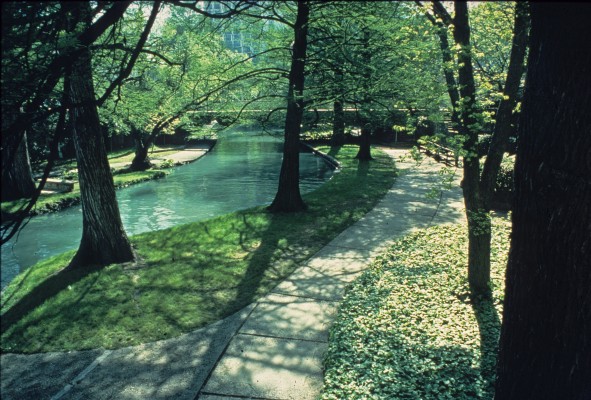Paseo del Rio
In September 1921 a disastrous flood ravaged downtown San Antonio. Water depth was measured at more than eight feet on some downtown streets. Over fifty people were killed and property damage totaled more than $50 million. Public outcry demanded that a solution be found. San Antonio would double its population in the decade of the 1920s, and the growing city keenly felt the need to heal the recurring sore created by the meandering little river that ran through its core.
Largely hidden from view, the river was lined at the time by deteriorating buildings that mostly addressed it with their backsides. Its banks were littered and unkempt and its water often polluted. Most downtown inhabitants considered the river a nuisance. It was no surprise, therefore, that the engineering firm hired by the City of San Antonio to propose solutions to the flood problem recommended that certain channels of the river be concreted and that the Horseshoe Bend area, now known as the Paseo del Rio, be filled in.
The recommendations, however, met stiff opposition not only from the always watchful San Antonio Conservation Society but also from the influential City Federation of Women’s Clubs. The groups lobbied to save their “lovely winding San Antonio River” but required an alternative plan in order to deter the city from following its engineers’ recommendations. In June 1929 such an alternative was proposed in a meeting of city officials, property owners, and civic leaders arranged by the Conservation Society. In that meeting a twenty-seven-year-old architect named Robert H. H. Hugman outlined a vision for the area which combined romance and nostalgia with promotional good sense and predicted the beautiful and evocative Paseo del Rio as we know it today.
Hugman wove a tale at the meeting of “old cities in Spain, of a narrow winding street barred to vehicular traffic yet holding the best shops, clubs, banks and cafes; prosperous, yet alluring with its shadowed doorways and quaint atmosphere” (quote in A Dream Come True: Robert H. H. Hugman and the San Antonio River Walk, 1983, p. 34). He sought to convince property owners of the economic advantages such a plan would provide. He attempted to persuade the mayor and other government officials of the proposed development’s contribution to San Antonio’s growing tourist industry, especially by virtue of its close proximity to the Alamo. He appealed to conservationists to help keep the historic river path intact. Hugman’s proposal was well received, gaining the endorsement of numerous civic groups. In October 1929 the City Federation of Women’s Clubs formally requested that the city hire Hugman to develop plans to beautify and develop the river. But funding was scarce, and no action was taken. It was not until December 1938, after almost ten years of lobbying, speaking to civic groups, writing newspaper articles, and calling on community business leaders, that Hugman was finally employed as architect of the San Antonio River beautification project.

Funding for the river project came largely from the federal Work Projects Administration (WPA), having been secured by the tireless efforts of local hotel owner Jack White. The river was drained and the channel was cleaned and deepened – a messy and tedious task accomplished largely by hand labor with shovels and wheelbarrows. A concerted effort was made to preserve the mature cypress trees that lined the river by covering exposed roots and watering them regularly. Additional cypress trees were brought in from the nearby Guadalupe River to supplement existing ones. In all, over 11 ,000 trees and shrubs were added to the banks of the river, including over 1,500 exotic banana trees.
Over the course of the two-and-a half-year WPA river project, 8,500 feet of bank were improved, affecting twenty-one city blocks. Over 17,000 feet of river walks and sidewalks were built, as well as thirty-one stairways leading to the river bank from twenty-one bridges. The craftsmanship in stone, brick, and concrete paving as well as in construction of benches, stairs, and bridges is skilled and inventive. Approximately one thousand workers were employed in the intentionally labor-intensive project.
Hugman’s design work fulfills the promise of his seminal concept. Surfaces of the district are rich and tactile. Paths are gentle and graceful. Landscape is lush and sheltering. Unfortunately, however, due to political disagreements, Hugman was not allowed to see the beautification project to completion. In March 1940 he sadly turned over his plans for the San Antonio River to another architect, J. Fred Buenz, for the final year of supervision.
Since 1941 the Paseo del Rio has had a somewhat checkered history. In the early 1950s derelicts and vandals inhabited the river banks, giving the area a bad reputation that was difficult to overcome. In 1962 the River Walk District and the River Walk Advisory Commissions were created to work with the Chamber of Commerce and the local chapter of the American Institute of Architects to prepare a developmental master plan for the river bend area. This led to a second major effort to enhance the river walk, initiated in early 1964.
It was during that campaign that the commercial and activity development of the river, which Hugman had included as an integral part of his initial vision almost forty years earlier, began to take firm root. Today, the Paseo del Rio is a linear paradise blending nature and commercial uses in a lush display of color, texture, activity, and aroma. Twenty feet below the noisy street, the river hosts an idyllic world of its own, giving special character to a city that once threatened its existence.